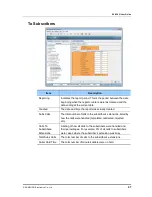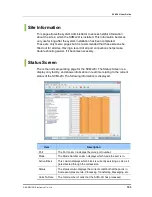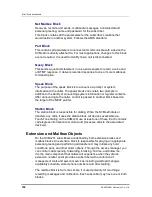
SVMi-20i User Guide
© SAMSUNG Electronics Co., Ltd.
109
Call Directors
Call Directors are powerful tools used to connect the various blocks together.
All blocks that pass control of a call to another block use Call Directors.
Call Directors pass control of a call to the next block. Which block they pass
control to is dependent on certain conditions, called events, that have
occurred within the current block.
Events may include no entry, invalid entry, no message left, operator
requested, and user exit. There are many possible events and they will vary
depending on the type of block being programmed.
In a Menu block, the Call Director is called the ‘Menu Input Processor’ and
also acts on data entered by a caller.
In an Extension block, the Call Director is called the ‘Caller Options
Processor’ and also acts on data entered by a caller.
In a Mode block, the Call Director is called the ‘Call Code Processor’ and
also acts on call type data received from the system.
The Bye block and the Station block do not have Call Directors, as they are
considered the end of a call control path.
Event Pointers
A Call Director uses EVENT POINTERS to pass control of a call to the next
block. All EVENT POINTERS consist of an INPUT value, an ACTION, a
Block TYPE, and a TARGET.
An INPUT value is a collection of digits, whether received from a caller via
DTMF, telephone system or network integration information, collected in the
block. An ACTION is that which takes place when input from a caller equals
the INPUT value. TYPE is a type of block to pass control to. There are five
types of ACTIONS: GOTO, TRANSLATE, PASSWORD, SEARCH ON, and
FILE. The TARGET is the name of the block to pass control to next.
Modes
At any time of the day, the SVMi-20i is in a specific operating mode.
This may be as simple as Day Mode (business hour) or Night Mode
(business closed), or it can be very complex (Special Mode for Port 2 Only,
on July 19th between 7 and 8 p.m.). New modes may be added as needed.
The times that operating modes are effective are defined in the Schedule
Table.
The behavior of the SVMi-20i when it answers a new call during each
specific operating mode is defined in the Mode block.
The SVMi-20i can be made to change modes either manually, by using
special administrative commands, or automatically as specified in the
Schedule Table.
Содержание SVMi-20i
Страница 1: ...Ver 2600 00DMMRGAN 3 0 SVMi 20i User Guide ...
Страница 6: ...Error Style not defined 6 SAMSUNG Electronics Co Ltd This page is intentionally left blank ...
Страница 10: ...TABLE OF CONTENTS 10 SAMSUNG Electronics Co Ltd This page is intentionally left blank ...
Страница 68: ...Error Style not defined 68 SAMSUNG Electronics Co Ltd This page is intentionally left blank ...
Страница 244: ...Error Style not defined 244 SAMSUNG Electronics Co Ltd This page is intentionally left blank ...
















































